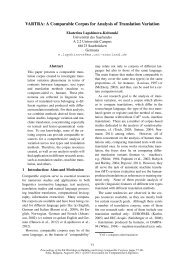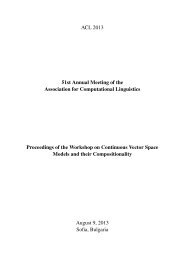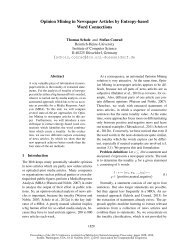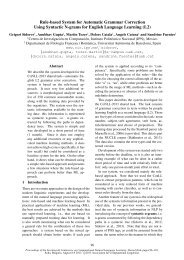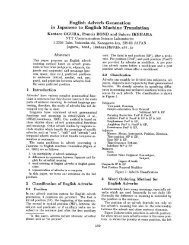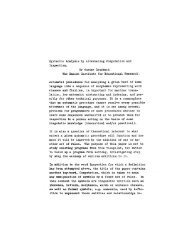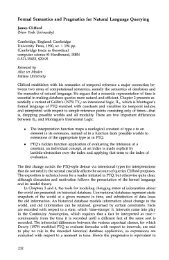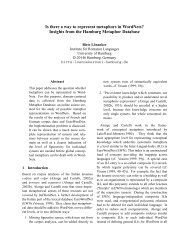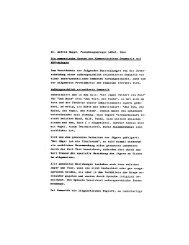Unraveling Infinite Jest - the Association for Computational Linguistics
Unraveling Infinite Jest - the Association for Computational Linguistics
Unraveling Infinite Jest - the Association for Computational Linguistics
You also want an ePaper? Increase the reach of your titles
YUMPU automatically turns print PDFs into web optimized ePapers that Google loves.
Multiple Narrative Disentanglement: <strong>Unraveling</strong> <strong>Infinite</strong> <strong>Jest</strong><br />
Abstract<br />
Many works (of both fiction and non-fiction)<br />
span multiple, intersecting narratives, each of<br />
which constitutes a story in its own right. In<br />
this work I introduce <strong>the</strong> task of multiple narrative<br />
disentanglement (MND), in which <strong>the</strong><br />
aim is to tease <strong>the</strong>se narratives apart by assigning<br />
passages from a text to <strong>the</strong> sub-narratives<br />
to which <strong>the</strong>y belong. The motivating example<br />
I use is David Foster Wallace’s fictional<br />
text <strong>Infinite</strong> <strong>Jest</strong>. I selected this book because<br />
it contains multiple, interweaving narratives<br />
within its sprawling 1,000-plus pages. I propose<br />
and evaluate a novel unsupervised approach<br />
to MND that is motivated by <strong>the</strong> <strong>the</strong>ory<br />
of narratology. This method achieves strong<br />
empirical results, successfully disentangling<br />
<strong>the</strong> threads in <strong>Infinite</strong> <strong>Jest</strong> and significantly<br />
outper<strong>for</strong>ming baseline strategies in doing so.<br />
1 Introduction<br />
Both fictional and non-fictional texts often comprise<br />
multiple, intersecting and inter-related narrative<br />
arcs. This work considers <strong>the</strong> task of identifying<br />
<strong>the</strong> (sub-)narratives latent within a narrative text and<br />
<strong>the</strong> set of passages that comprise <strong>the</strong>m. As a motivating<br />
example, I consider David Foster Wallace’s<br />
opus <strong>Infinite</strong> <strong>Jest</strong> (Wallace, 1996), 1 which contains<br />
several disparate sub-narratives interleaved throughout<br />
its voluminous (meta-)story. By sub-narrative<br />
I mean, loosely, that <strong>the</strong>se threads constitute <strong>the</strong>ir<br />
own independent stories, coherent on <strong>the</strong>ir own (i.e.,<br />
1 No relation.<br />
Byron C. Wallace<br />
Tufts University and Tufts Medical Center<br />
Boston, MA<br />
byron.wallace@gmail.com<br />
1<br />
without <strong>the</strong> broader context of <strong>the</strong> overarching narrative).<br />
I refer to <strong>the</strong> task of identifying <strong>the</strong>se independent<br />
threads and untangling <strong>the</strong>m from one ano<strong>the</strong>r<br />
as multiple narrative disentanglement (MND).<br />
The task is of <strong>the</strong>oretical interest because disentanglement<br />
is a necessary pre-requisite to making<br />
sense of narrative texts, an interesting direction in<br />
NLP that has received an increasing amount of attention<br />
(Elson et al., 2010; Elson and McKeown, 2010;<br />
Celikyilmaz et al., 2010; Chambers and Jurafsky,<br />
2008; Chambers and Jurafsky, 2009). Recognizing<br />
<strong>the</strong> (main) narrative threads comprising a work<br />
provides a context <strong>for</strong> interpreting <strong>the</strong> text. Disentanglement<br />
may thus be viewed as <strong>the</strong> first step in<br />
a literary processing ‘pipeline’. Identifying threads<br />
and assigning <strong>the</strong>m to passages may help in automatic<br />
plot summarization, social network construction<br />
and o<strong>the</strong>r literary analysis tasks. <strong>Computational</strong><br />
approaches to literature look to make narrative sense<br />
of unstructured text, i.e., construct models that relate<br />
characters and events chronologically: disentanglement<br />
is at <strong>the</strong> heart of this re-construction.<br />
But MND is also potentially of more pragmatic<br />
import: disentanglement may be useful <strong>for</strong> identifying<br />
and extracting disparate threads in, e.g., a newsmagazine<br />
article that covers multiple (related) stories.<br />
2 Consider an article covering a political race.<br />
It would likely contain multiple sub-narratives (<strong>the</strong><br />
story of one candidate’s rise and fall, a scandal in a<br />
political party, etc.) that may be of interest independently<br />
of <strong>the</strong> particular race at hand. Narrative dis-<br />
2 While narrative colloquially tends to refer to fictional texts,<br />
<strong>the</strong> narrative voice is also frequently used in non-fictional contexts<br />
(Bal, 1997).<br />
2012 Conference of <strong>the</strong> North American Chapter of <strong>the</strong> <strong>Association</strong> <strong>for</strong> <strong>Computational</strong> <strong>Linguistics</strong>: Human Language Technologies, pages 1–10,<br />
Montréal, Canada, June 3-8, 2012. c○2012 <strong>Association</strong> <strong>for</strong> <strong>Computational</strong> <strong>Linguistics</strong>
entanglement thus has applications outside of computational<br />
methods <strong>for</strong> fiction.<br />
In this work, I treat MND as an unsupervised<br />
learning task. Given a block of narrative text, <strong>the</strong><br />
aim is to identify <strong>the</strong> top k sub-narratives <strong>the</strong>rein,<br />
and <strong>the</strong>n to extract <strong>the</strong> passages comprising <strong>the</strong>m.<br />
The proposed task is similar in spirit to <strong>the</strong> problem<br />
of chat disentanglement (Elsner and Charniak,<br />
2010), in which <strong>the</strong> aim is to assign each utterance in<br />
a chat transcription to an associated conversational<br />
thread. Indeed, <strong>the</strong> main objective is <strong>the</strong> same: disentangle<br />
fragments of a monolithic text into chronologically<br />
ordered, independently coherent ‘threads’.<br />
Despite <strong>the</strong>ir similarities, however, narrative disentanglement<br />
is a qualitatively different task than chat<br />
disentanglement, as I highlight in Section 3.<br />
I take inspiration from <strong>the</strong> literary community,<br />
which has studied <strong>the</strong> <strong>the</strong>oretical underpinnings of<br />
<strong>the</strong> narrative <strong>for</strong>m at length (Prince, 1982; Prince,<br />
2003; Abbott, 2008). I rely especially on <strong>the</strong> seminal<br />
work of Bal (1997), Narratology, which provides<br />
a comprehensive <strong>the</strong>oretical framework <strong>for</strong> treating<br />
narratives. This narratological <strong>the</strong>ory motivates my<br />
strategy of narrative modeling, in which I first extract<br />
<strong>the</strong> entities in each passage of a text. I <strong>the</strong>n<br />
uncover <strong>the</strong> latent narrative compositions of <strong>the</strong>se<br />
passages by per<strong>for</strong>ming latent Dirichlet allocation<br />
(LDA) (Blei et al., 2003) over <strong>the</strong> extracted entities.<br />
The main contributions of this work are as follows.<br />
First, I introduce <strong>the</strong> task of multiple narrative<br />
disentanglement (MND). Second, motivated by <strong>the</strong><br />
<strong>the</strong>ory of narratology (Section 2) I propose a novel,<br />
unsupervised method <strong>for</strong> this task (Section 5) and<br />
demonstrate its superiority over baseline strategies<br />
empirically (Section 6). Finally, I make available a<br />
corpus <strong>for</strong> this task: <strong>the</strong> text of <strong>Infinite</strong> <strong>Jest</strong> manually<br />
annotated with narrative tags (Section 4).<br />
2 Narratology<br />
I now introduce some useful definitions and concepts<br />
(Table 1) central to <strong>the</strong> <strong>the</strong>ory of narratology<br />
(Bal, 1997). These constructs motivate my approach<br />
to <strong>the</strong> task of disentanglement.<br />
These definitions imply that <strong>the</strong> observed narrative<br />
text has been generated with respect to some<br />
number of latent fabulas. A story is a particular<br />
telling of an underlying fabula, i.e., a sequence of<br />
2<br />
Actor an agent that per<strong>for</strong>ms actions. Actors<br />
are not necessarily persons.<br />
Fabula a series of logically and chronologically<br />
related events that are caused<br />
or experienced by actors.<br />
Story an instantiation of a fabula, told in<br />
a particular style (a story tells a fabula).<br />
Stories are not necessarily told<br />
in chronological order.<br />
Focalizer a special actor from whose point of<br />
view <strong>the</strong> story is told.<br />
Table 1: A small glossary of narratology.<br />
events involving actors. Figure 1 schematizes <strong>the</strong><br />
relationships between <strong>the</strong> above constructs. The<br />
dotted line between author and fabula implies that<br />
authors sometimes generate <strong>the</strong> fabula, sometimes<br />
not. In particular, an author may re-tell a widely<br />
known fabula (e.g., Hamlet); perhaps from a different<br />
perspective. Consider, <strong>for</strong> example, <strong>the</strong> play<br />
Rosencrantz and Guildenstern are Dead (Stoppard,<br />
1967), a narrative that re-tells <strong>the</strong> fabula of Hamlet<br />
from <strong>the</strong> perspective of <strong>the</strong> titular characters (both<br />
of whom play a minor part in Hamlet itself). From<br />
a narratological view, this story is an instantiation of<br />
<strong>the</strong> Hamlet fabula imbued with novel aspects (e.g.,<br />
<strong>the</strong> focalizers in this telling are Rosencrantz and<br />
Guildenstern, ra<strong>the</strong>r than Hamlet). In non-fictional<br />
works <strong>the</strong> fabula corresponds to <strong>the</strong> actual event sequence<br />
as it happened, and thus is not invented by<br />
<strong>the</strong> author (save <strong>for</strong> cases of outright fabrication).<br />
Fabulas are essentially actor-driven. Fur<strong>the</strong>r, actors<br />
tend to occupy particular places, and indeed Bal<br />
(1997) highlights locations as one of <strong>the</strong> defining elements<br />
of fabulas. Given <strong>the</strong>se observations, it thus<br />
seems fruitful to attempt to identify <strong>the</strong> agents and<br />
locations (or entities) in each passage of a text as a<br />
first step toward disentanglement. I will return to<br />
this intuition when I present <strong>the</strong> narrative modeling<br />
method in Section 5. First, I place <strong>the</strong> present work<br />
in context by relating it to existing work on mining<br />
literature and chat disentanglement.<br />
3 Relationship to Existing Work<br />
Most similar to MND is <strong>the</strong> task of chat disentanglement<br />
(Shen et al., 2006; Elsner and Charniak,<br />
2010; Elsner and Charniak, 2011), wherein utterances<br />
(perhaps overheard at a cocktail party) are to
Fabula<br />
Story<br />
Symbols<br />
(e.g., text)<br />
Author<br />
Figure 1: A schematic of <strong>the</strong> narratology <strong>the</strong>ory. The<br />
dotted line between author and fabula implies that when<br />
generating a narrative text, an author may invent a fabula,<br />
or may draw upon an existing one. Toge<strong>the</strong>r, <strong>the</strong> author<br />
and fabula jointly give rise to <strong>the</strong> story, which is communicated<br />
via <strong>the</strong> text.<br />
be assigned to conversational threads. There are,<br />
however, important differences between <strong>the</strong>se two<br />
tasks. Notably, utterances in a chat belong to a single<br />
discussion thread, motivating ‘hard’ assignments of<br />
utterances to threads, e.g., using graph-partitioning<br />
(Elsner and Charniak, 2010) or k-means like approaches<br />
(Shen et al., 2006). Narratives, however,<br />
often intersect: a single passage may belong to multiple<br />
narrative threads. This motivates soft, probabilistic<br />
assignments of passages to threads. Moreover,<br />
narratives are inherently hierarchical. The latter<br />
two observations suggest that probabilistic generative<br />
models are appropriate <strong>for</strong> MND.<br />
There has also been recent interesting related<br />
work in <strong>the</strong> unsupervised induction of narrative<br />
schemas (Chambers and Jurafsky, 2008; Chambers<br />
and Jurafsky, 2009). In this work, <strong>the</strong> authors proposed<br />
<strong>the</strong> task of (automatically) discovering <strong>the</strong><br />
events comprising a narrative chain. Here narrative<br />
event chains were defined by Chambers and Jurafsky<br />
(2008) as partially ordered sets of events involving<br />
<strong>the</strong> same protagonist. While similar in that <strong>the</strong>se<br />
works attempt to make sense of narrative texts, <strong>the</strong><br />
task at hand is quite different.<br />
In particular, narrative schema induction presupposes<br />
a single narrative thread. Indeed, <strong>the</strong> authors<br />
explicitly make <strong>the</strong> assumption that a single<br />
protagonist participates in all of <strong>the</strong> events <strong>for</strong>ming<br />
a narrative chain. Thus <strong>the</strong> discovered chains de-<br />
3<br />
scribe actions experienced by <strong>the</strong> protagonist localized<br />
within a particular narrative structure. By contrast,<br />
in this work I treat narrative texts as instantiations<br />
of fabulas, in line with Bal (1997). Fabulas<br />
can be viewed as distributions over characters,<br />
events and o<strong>the</strong>r entities; this conceptualization<br />
of what constitutes a narrative is broader than<br />
Chambers and Jurafsky (2008). inducing narrative<br />
schemas (Chambers and Jurafsky, 2009) may be<br />
viewed as a possible next step in a narrative induction<br />
pipeline, subsequent to disentangling <strong>the</strong> text<br />
comprising individual narrative threads. Indeed, <strong>the</strong><br />
latter task might be viewed as attempting to automatically<br />
re-construct <strong>the</strong> fabula latent in a specific<br />
narrative thread.<br />
Elsewhere, Elson et al. (2010) proposed a method<br />
<strong>for</strong> extracting social networks from literary texts.<br />
Their method relies on dialogue detection. This is<br />
used to construct a graph representing social interactions,<br />
in which an edge connecting two characters<br />
implies that <strong>the</strong>y have interacted at least once;<br />
<strong>the</strong> weight of <strong>the</strong> edge encodes <strong>the</strong> frequency of<br />
<strong>the</strong>ir interactions. Their method is a pipelined process<br />
comprising three steps: character identification,<br />
speech attribution and, finally, graph construction.<br />
Their results from <strong>the</strong> application of this method to<br />
a large collection of novels called into question a<br />
long-held literary hypo<strong>the</strong>sis: namely that <strong>the</strong>re is<br />
an inverse correlation between <strong>the</strong> number of characters<br />
in a novel and <strong>the</strong> amount of dialogue it contains<br />
(Moretti, 2005) (it seems <strong>the</strong>re is not). By answering<br />
a literary question empirically, <strong>the</strong>ir work<br />
demonstrates <strong>the</strong> power of computational methods<br />
<strong>for</strong> literature analysis.<br />
4 Corpus (<strong>Infinite</strong> <strong>Jest</strong>)<br />
I introduce a new corpus <strong>for</strong> <strong>the</strong> task of multiple narrative<br />
disentanglement (MND): David Foster Wallace’s<br />
novel <strong>Infinite</strong> <strong>Jest</strong> (Wallace, 1996) that I have<br />
manually annotated with narrative tags. 3 <strong>Infinite</strong><br />
<strong>Jest</strong> is an instructive example <strong>for</strong> experimenting with<br />
MND, as <strong>the</strong> story moves frequently between a few<br />
mostly independent – though ultimately connected<br />
and occasionally intersecting – narrative threads.<br />
3 Available at http://github.com/bwallace/computationaljest.<br />
I also note that <strong>the</strong> text comprises ∼100 pages of footnotes, but<br />
I did not annotate <strong>the</strong>se.
Annotation, i.e., manually assigning text to one<br />
or more narratives, is tricky due primarily to having<br />
to make decisions about new thread designation<br />
and label granularity. 4 Start with <strong>the</strong> first. There<br />
is an inherent subjectivity in deciding what constitutes<br />
a narrative thread. In this work, I was liberal<br />
in making this designation, in total assigning 49<br />
unique narrative labels. Most of <strong>the</strong>se tell <strong>the</strong> story<br />
of particular (minor) characters, who are <strong>the</strong>mselves<br />
actors in a ‘higher-level’ narrative – as previously<br />
mentioned, narrative structures are inherently hierarchical.<br />
This motivates my liberal introduction of<br />
narratives: lesser threads are subsumed by <strong>the</strong>ir parent<br />
narratives, and can thus simply be ignored during<br />
analysis if one is uninterested in <strong>the</strong>m. Indeed, this<br />
work focuses only on <strong>the</strong> three main narratives in <strong>the</strong><br />
text (see below).<br />
Granularity poses ano<strong>the</strong>r challenge. At what<br />
level ought <strong>the</strong> text be annotated? Should each sentence<br />
be tagged with associated threads? Each paragraph?<br />
I let context guide this decision: in some<br />
cases tags span a single sentence; more often <strong>the</strong>y<br />
span paragraphs. As an example, consider <strong>the</strong> following<br />
example of annotated text, wherein <strong>the</strong> AFR<br />
briefly narrative intersects <strong>the</strong> story of <strong>the</strong> ETA (see<br />
Table 2).<br />
Mara<strong>the</strong> was charged with this operation’s<br />
details ... A direct assault upon <strong>the</strong><br />
Academy of Tennis itself was impossible. A.F.R.s<br />
fear nothing in this hemisphere except tall and steep<br />
hillsides. ... <br />
Here <strong>the</strong> ellipses spans several paragraphs. Precision<br />
probably matters less than context in MND: identifying<br />
only sentences that involve a particular subnarrative,<br />
sans context, would probably not be useful.<br />
Because <strong>the</strong> appropriate level of granularity depends<br />
on <strong>the</strong> corpus at hand, <strong>the</strong> task of segmenting<br />
<strong>the</strong> text into useful chunks is a sub-task of MND.<br />
I refer to <strong>the</strong> segmented pieces of text as passages<br />
and say that a passage belongs to all of <strong>the</strong> narrative<br />
threads that appear anywhere within it. Hence in <strong>the</strong><br />
above example, <strong>the</strong> passage containing this excerpt<br />
would be designated as belonging to both <strong>the</strong> ETA<br />
and AFR threads.<br />
4 These complexities seem to be inherent to disentanglement<br />
tasks in general: Elsner and Charniak (2010) describe analogues<br />
issues in <strong>the</strong> case of chat.<br />
4<br />
AFR This is <strong>the</strong> tale of <strong>the</strong> wheelchair assassins, a<br />
Quèbècois terrorist group, and <strong>the</strong>ir attempts to<br />
seize an original copy of a dangerous film. Focalizer:<br />
Mara<strong>the</strong>.<br />
EHDRH The Ennet House Drug Recovery House (sic).<br />
This narrative concerns <strong>the</strong> going-ons at a drug<br />
recovery house. Focalizer: Don Gately.<br />
ETA This narrative follows <strong>the</strong> students and faculty<br />
at <strong>the</strong> Enfield Tennis Academy. Focalizer: Hal.<br />
Table 2: Brief summaries of <strong>the</strong> main narratives comprising<br />
<strong>Infinite</strong> <strong>Jest</strong>.<br />
narrative # of passages prevalence<br />
AFR 30 16%<br />
EHDRH 42 23%<br />
ETA 69 38%<br />
Table 3: Summary statistics <strong>for</strong> <strong>the</strong> three main narratives.<br />
<strong>Infinite</strong> <strong>Jest</strong> is naturally segmented by breaks,<br />
i.e., blank lines in <strong>the</strong> text which typically indicate<br />
some sort of context-shift (functionally, <strong>the</strong>se are<br />
like mini-chapters). There are 182 such breaks in<br />
<strong>the</strong> book, demarcating 183 passages. Each of <strong>the</strong>se<br />
comprises about 16,000 words and contains an average<br />
of 4.6 (out of 49) narratives, according to my<br />
annotations.<br />
There are three main narrative threads in <strong>Infinite</strong><br />
<strong>Jest</strong>, summarized briefly in Table 2. 5 I am not alone<br />
in designating <strong>the</strong>se as <strong>the</strong> central plot-lines in <strong>the</strong><br />
book. 6 Nearly all of <strong>the</strong> o<strong>the</strong>r threads in <strong>the</strong> text are<br />
subsumed by <strong>the</strong>se (toge<strong>the</strong>r <strong>the</strong> three cover 72%<br />
of <strong>the</strong> passages in <strong>the</strong> book). These three main<br />
threads are ideal <strong>for</strong> evaluating an MND system, <strong>for</strong><br />
a few reasons. First, <strong>the</strong>y are largely independent of<br />
one ano<strong>the</strong>r, i.e., overlap only occasionally (though<br />
<strong>the</strong>y do overlap). Second, <strong>the</strong>y are relatively unambiguous:<br />
it is mostly clear when a passage tells a<br />
piece of one of <strong>the</strong>se story-lines, and when it does<br />
not. These narratives are thus well-defined, providing<br />
a minimal-noise dataset <strong>for</strong> <strong>the</strong> task of MND.<br />
That I am <strong>the</strong> single annotator of <strong>the</strong> corpus (and<br />
hence inter-annotator agreement cannot be assessed)<br />
is un<strong>for</strong>tunate; <strong>the</strong> difficulty of finding someone both<br />
qualified and willing to annotate <strong>the</strong> 1000+ page<br />
book precluded this possibility. I hope to address<br />
5 I include <strong>the</strong>se only <strong>for</strong> interested readers: <strong>the</strong> descriptions<br />
are not technically important <strong>for</strong> <strong>the</strong> work here, and one may<br />
equivalently substitute ‘narrative 1’, ‘narrative 2’, etc.<br />
6 e.g., http://www.sampottsinc.com/ij/file/IJ Diagram.pdf.
eling is per<strong>for</strong>med over <strong>the</strong> entities, ra<strong>the</strong>r than <strong>the</strong><br />
text, I shall refer to it as narrative modeling.<br />
As mentioned above, Step (1) will be taskspecific:<br />
what constitutes a passage is inherently<br />
subjective. In many cases, however, <strong>the</strong> text will<br />
lend itself to a ‘natural’ segmenting, e.g., at <strong>the</strong><br />
chapter-level. Standard statistical techniques <strong>for</strong><br />
named entity recognition (NER) can be used <strong>for</strong><br />
Step (2) (McCallum and Li, 2003).<br />
Algorithm 1 The story of LDA over extracted entities<br />
<strong>for</strong> multiple narrative disentanglement.<br />
Draw a mixture of narrative threads θ ∼ Dir(α)<br />
<strong>for</strong> each entity in <strong>the</strong> passage ei do<br />
Draw a narrative thread ti ∼ Multinomial(θ)<br />
Draw ei from p(ei|ti)<br />
end <strong>for</strong><br />
narrative text<br />
segmenter<br />
NER<br />
extractor<br />
narrative<br />
modeling<br />
passages<br />
extracted entities<br />
<strong>for</strong> passages<br />
Figure 4: The MND<br />
pipeline.<br />
For <strong>the</strong> narrative modeling<br />
Step (3), I use LDA<br />
(Blei et al., 2003); <strong>the</strong><br />
generative story <strong>for</strong> narrative<br />
modeling is told<br />
by Algorithm 1. 8 This<br />
squares with <strong>the</strong> narratological<br />
view: entities<br />
are observed in <strong>the</strong> text<br />
with probability proportional<br />
to <strong>the</strong>ir likelihood<br />
of being drawn from <strong>the</strong><br />
corresponding latent fabulas<br />
(which we are attempting<br />
to recover). Focusing<br />
on <strong>the</strong>se entities, ra<strong>the</strong>r<br />
than <strong>the</strong> raw text, is crucial<br />
if one is to be compatible<br />
with <strong>the</strong> narratological<br />
view. The text is merely a particular telling of <strong>the</strong><br />
underlying fabula, made noisy by story specific aspects;<br />
extracting entities from <strong>the</strong> passages effectively<br />
removes this noise, allowing <strong>the</strong> model to operate<br />
over a space more closely tied to <strong>the</strong> fabulas.<br />
In <strong>the</strong> following section, I demonstrate that this shift<br />
to <strong>the</strong> entity-space substantially boosts MND per<strong>for</strong>mance.<br />
8 Liu and Liu (2008) have also proposed topic models over<br />
NEs, though in a very different context.<br />
6<br />
The aim is to uncover <strong>the</strong> top k most salient narrative<br />
threads in a text, where k is a user-provided<br />
parameter. Indeed one must specify <strong>the</strong> number of<br />
threads he or she is interested in identifying (and disentangling),<br />
because because, due to <strong>the</strong> hierarchical<br />
nature of narratives, <strong>the</strong>re is no single ‘right number’<br />
of <strong>the</strong>m. Consider that <strong>the</strong> input block of text constitutes<br />
a perfectly legitimate (meta-)narrative on its<br />
own, <strong>for</strong> example. A related issue that must be addressed<br />
is that of deciding when to assign a passage<br />
to multiple threads. That is, given <strong>the</strong> (estimated)<br />
narrative mixtures <strong>for</strong> each passage as an input, to<br />
which (if any) narrative threads ought this passage<br />
be assigned?<br />
My approach to this is two-fold. First, I set a<br />
threshold probability α such that a passage pi cannot<br />
be assigned to a narrative thread t if <strong>the</strong> estimated<br />
mixture component is ≤ α. I use α = 1/k, as<br />
this value implies that <strong>the</strong> passage is dominated by<br />
o<strong>the</strong>r threads (in <strong>the</strong> case that all k threads contribute<br />
equally to a passage, <strong>the</strong> corresponding mixture elements<br />
would all be 1/k). Second, I en<strong>for</strong>ce a constraint<br />
that in order to be assigned to <strong>the</strong> narrative t,<br />
a passage must contain at least one of <strong>the</strong> top l entities<br />
involved in t (according to <strong>the</strong> narrative model).<br />
This constraint encodes <strong>the</strong> intuition that <strong>the</strong> main<br />
actors (and locations) that constitute a given fabula<br />
are (extremely) likely to be present in any given passage<br />
in which it is latent. I set l = 100, reflecting<br />
intuition. These were <strong>the</strong> first values I used <strong>for</strong> both<br />
of <strong>the</strong>se parameters; I did not tune <strong>the</strong>m to <strong>the</strong> corpus<br />
at hand. I did, however, experiment with o<strong>the</strong>r<br />
values after <strong>the</strong> primary analysis to assess sensitivity.<br />
The proposed algorithm is not terribly sensitive<br />
to ei<strong>the</strong>r parameter, though both exert influence in<br />
<strong>the</strong> expected directions: increasing α decreases recall,<br />
as passages are less likely to be assigned to narratives.<br />
Decreasing l has a similar effect, but does<br />
not substantially impact per<strong>for</strong>mance unless extreme<br />
values are used. 9<br />
5.1 Focalizer Detection<br />
Recall that <strong>the</strong> focalizer of a narrative is <strong>the</strong> agent<br />
responsible <strong>for</strong> perception: it is from <strong>the</strong>ir point of<br />
view that <strong>the</strong> story is told (Bal, 1997). One can easily<br />
exploit <strong>the</strong> narrative modeling method above to<br />
9 Fewer than 10 or more than 500, <strong>for</strong> example.
automatically identify <strong>the</strong> (main) focalizer of <strong>the</strong> uncovered<br />
narratives. 10 To this end, I simply identify<br />
<strong>the</strong> highest ranking entity from each narrative that<br />
has also been labeled as a ‘person’ (as opposed, e.g.,<br />
to an ‘organization’).<br />
6 Empirical Results<br />
I now present experimental results over <strong>the</strong> <strong>Infinite</strong><br />
<strong>Jest</strong> corpus, described in Section 4. The task here is<br />
to uncover <strong>the</strong> three main narratives in <strong>the</strong> text, depicted<br />
in Figure 2. To implement <strong>the</strong> proposed narrative<br />
modeling method (Section 5), I first chunked<br />
<strong>the</strong> text into passages, delineated in <strong>Jest</strong> by breaks<br />
in <strong>the</strong> text. I per<strong>for</strong>med entity extraction over <strong>the</strong>se<br />
passages using <strong>the</strong> NLTK toolkit (Bird et al., 2009).<br />
I <strong>the</strong>n per<strong>for</strong>med LDA via Mallet (McCallum, 2002)<br />
to estimate <strong>the</strong> narrative mixture components of each<br />
passage.<br />
recall = T P/(T P + F N) (1)<br />
precision = T P/(T P + F P ) (2)<br />
F =<br />
precision · recall<br />
2 ·<br />
precision + recall<br />
(3)<br />
I compare <strong>the</strong> narrative modeling approach presented<br />
in <strong>the</strong> preceding section to three baselines.<br />
The simplest of <strong>the</strong>se, round-robin and all-same<br />
are similar to <strong>the</strong> baselines used <strong>for</strong> chat disentanglement<br />
(Elsner and Charniak, 2010). Respectively,<br />
<strong>the</strong>se strategies designate each passage as: belonging<br />
to <strong>the</strong> next narrative in a given sequence (‘narrative<br />
1’, ‘narrative 2’, ‘narrative 3’), and, belonging<br />
to <strong>the</strong> majority narrative. In both cases I show <strong>the</strong><br />
best result attainable using <strong>the</strong> method: thus in <strong>the</strong><br />
case of <strong>the</strong> <strong>for</strong>mer, I report <strong>the</strong> best scoring results<br />
from all 3! possible thread sequences (with respect<br />
to macro-averaged F-score) and in <strong>the</strong> latter case I<br />
use <strong>the</strong> true majority narrative.<br />
I also evaluate a simple topic-modeling baseline,<br />
which is <strong>the</strong> same as narrative modeling, except that:<br />
1) LDA is per<strong>for</strong>med over <strong>the</strong> full-text (ra<strong>the</strong>r than<br />
<strong>the</strong> extracted entities) and, 2) <strong>the</strong>re is no constraint<br />
en<strong>for</strong>cing that passages reference an entity associated<br />
with <strong>the</strong> assigned narrative. I evaluate results<br />
with respect to per-narrative recall, precision and<br />
F-score (Equations 1-3) (where TP=true positive,<br />
10 Technically, <strong>the</strong>re may be multiple focalizers in a narrative,<br />
but more often <strong>the</strong>re is only one.<br />
7<br />
FN=false negative, etc.). I also consider micro- and<br />
macro-averages of <strong>the</strong>se.<br />
To calculate <strong>the</strong> micro-average, one considers<br />
each passage at a time by counting up <strong>the</strong> TPs, FPs,<br />
TNs and FNs <strong>the</strong>rein <strong>for</strong> each narrative under consideration<br />
(w.r.t. <strong>the</strong> model being evaluated). The<br />
micro-average is <strong>the</strong>n calculated using <strong>the</strong>se tallied<br />
counts. Note that in this case certain narratives may<br />
contribute more to <strong>the</strong> overall result than o<strong>the</strong>rs, e.g.<br />
those that are common. By contrast, to calculate <strong>the</strong><br />
macro-average, one considers each narrative in turn<br />
and calculates <strong>the</strong> average of <strong>the</strong> metrics of interest<br />
(recall, precision) w.r.t. this narrative over all passages.<br />
An average is <strong>the</strong>n taken over <strong>the</strong>se mean per<strong>for</strong>mances.<br />
This captures <strong>the</strong> average per<strong>for</strong>mance<br />
of a model over all of <strong>the</strong> narratives, irrespective<br />
of <strong>the</strong>ir prevalence; in this case, each thread contributes<br />
equally to <strong>the</strong> overall result. Finally, note<br />
that none of <strong>the</strong> methods explicitly labels <strong>the</strong> narratives<br />
<strong>the</strong>y uncover: this assignment can be made by<br />
simply matching <strong>the</strong> returned narratives to <strong>the</strong> thread<br />
labels (e.g., ETA) that maximize per<strong>for</strong>mance. This<br />
labeling is strictly aes<strong>the</strong>tic; <strong>the</strong> aim is to recover <strong>the</strong><br />
latent narrative threads in text, not to label <strong>the</strong>m.<br />
Table 4 presents <strong>the</strong> main empirical results. Nei<strong>the</strong>r<br />
of <strong>the</strong> simple baseline methods (round-robin<br />
and all-same) per<strong>for</strong>med very well. Both cases, <strong>for</strong><br />
example, completely failed to identify <strong>the</strong> EHDRH<br />
thread (though this is hardly surprisingly in <strong>the</strong> allsame<br />
case, which identifies only one thread by definition).<br />
The macro-averaged precisions and Fmeasures<br />
are thus undefined in <strong>the</strong>se cases (<strong>the</strong>se<br />
give rise to a denominator of 0). With respect to<br />
micro-averaged per<strong>for</strong>mance, all-same achieves a<br />
substantially higher F-score than round-robin here,<br />
though in general this will be contingent on how<br />
dominated <strong>the</strong> text is by <strong>the</strong> majority thread.<br />
Next consider <strong>the</strong> two more sophisticated strategies,<br />
including <strong>the</strong> proposed narrative modeling<br />
method. Start with <strong>the</strong> per<strong>for</strong>mance of full-text<br />
TM, i.e., per<strong>for</strong>ming standard topic-modeling over<br />
<strong>the</strong> full-text. This method improves considerably on<br />
<strong>the</strong> baselines, achieving a macro-averaged F-score<br />
of .545. 11 But <strong>the</strong> narrative modeling method (Section<br />
5) per<strong>for</strong>ms substantially better, boosting <strong>the</strong><br />
11 In <strong>the</strong> full-text case, I evaluated <strong>the</strong> per<strong>for</strong>mance of every<br />
possible assignment of topics to threads, and report <strong>the</strong> best<br />
scoring result.
Figure 5: The unsupervised re-construction of <strong>the</strong> three main narratives using <strong>the</strong> narrative modeling approach.<br />
Hatched boxes denote false-positives (designating a passage as belonging to a narrative when it does not); empty<br />
boxes false negatives (failing to assign a passage to narrative to which it belongs).<br />
Figure 6: Results using full-text topic modeling (see above caption).<br />
macro-averaged F-score by over 15 points (a percent<br />
gain of nearly 30%).<br />
Figures 5 and 6 depict <strong>the</strong> unsupervised reconstruction<br />
of <strong>the</strong> narrative threads using narrative<br />
modeling and <strong>the</strong> full-text topic modeling approach,<br />
respectively. Recall that <strong>the</strong> aim is to re-construct<br />
<strong>the</strong> narratives depicted in Figure 2. In <strong>the</strong>se plots, an<br />
empty box represents a false negative (i.e., implies<br />
that this passage contained <strong>the</strong> corresponding narrative<br />
but this was not inferred by <strong>the</strong> model), and a<br />
hatched box denotes a false positive (<strong>the</strong> model assigned<br />
<strong>the</strong> passage to <strong>the</strong> corresponding narrative,<br />
but <strong>the</strong> passage did not belong to it). One can see<br />
that <strong>the</strong> narrative modeling method (Figure 5) reconstructs<br />
<strong>the</strong> hidden threads much better than does<br />
<strong>the</strong> full-text topic modeling approach (Figure 6).<br />
Once can see that <strong>the</strong> latter method has particular<br />
trouble with <strong>the</strong> EHDRH thread.<br />
I also experimented with <strong>the</strong> focalizer detection<br />
method proposed in Section 5.1. This simple strategy<br />
achieved 100% accuracy on <strong>the</strong> three main narratives,<br />
correctly identifying by name each of <strong>the</strong><br />
corresponding focalizers (see Table 2).<br />
8<br />
6.1 A More Entangled Thread<br />
The preceding results are positive, insofar as <strong>the</strong> proposed<br />
method substantially improves on baselines<br />
and is able to disentangle threads with relatively<br />
high fidelity. These results considered <strong>the</strong> three main<br />
narratives that comprise <strong>the</strong> novel (Figure 2). This<br />
is <strong>the</strong> sort of structure I believe will be most common<br />
in narrative disentanglement, as it is likely that<br />
one will mostly be interested in extracting coherent<br />
threads that are largely independent of one ano<strong>the</strong>r.<br />
That said, I will next consider a more entangled<br />
thread to see if <strong>the</strong> method handles <strong>the</strong>se well. More<br />
specifically, I introduce <strong>the</strong> narrative INC, which relates<br />
<strong>the</strong> story of <strong>the</strong> Incandenza family. This family<br />
is (arguably) <strong>the</strong> focus of <strong>the</strong> novel. The story of<br />
<strong>the</strong> Incandenza’s overlaps extremely frequently with<br />
<strong>the</strong> three main, mostly independent narratives considered<br />
thus far (see Figure 6). This thread is thus<br />
difficult from an MND perspective.<br />
I apply <strong>the</strong> same methods as above to this task, requesting<br />
four (ra<strong>the</strong>r than three) sub-narratives, i.e.,<br />
k = 4. Results are summarized in Table 5. 12 We ob-<br />
12 I omit <strong>the</strong> two baseline strategies due to space constraints;
ound-robin all-same full-text TM narrative modeling<br />
narrative recall prec. F recall prec. F recall prec. F recall prec. F<br />
AFR 0.433 0.210 0.283 0.000 undef. undef. 0.900 0.300 0.450 0.933 0.359 0.519<br />
EHDRH 0.000 undef. undef. 0.000 undef. undef. 0.786 0.402 0.532 0.929 0.736 0.821<br />
ETA 0.369 0.348 0.393 1.000 0.375 0.545 0.667 0.639 0.653 0.855 0.694 0.766<br />
macro-avg. 0.260 undef. undef. 0.333 undef. undef. 0.752 0.447 0.545 0.906 0.596 0.702<br />
micro-avg. 0.262 0.300 0.280 0.489 0.375 0.425 0.752 0.434 0.551 0.894 0.583 0.706<br />
Table 4: Empirical results using different strategies <strong>for</strong> MND. The top three rows correspond to per<strong>for</strong>mance <strong>for</strong><br />
individual narratives; <strong>the</strong> bottom two provide micro- and macro-averages, which are taken over <strong>the</strong> individual passages<br />
and <strong>the</strong> narrative-level results, respectively.<br />
Figure 7: The INC narrative thread (green, top). This narrative is substantially more entangled than <strong>the</strong> o<strong>the</strong>rs, i.e.,<br />
more frequently intersects with <strong>the</strong> o<strong>the</strong>r narratives.<br />
full-text TM narrative modeling<br />
narrative recall prec. F recall prec. F<br />
AFR 0.60 0.30 0.40 0.83 0.50 0.63<br />
EHDRH 0.83 0.57 0.67 0.79 0.75 0.77<br />
ETA 0.67 0.69 0.68 0.67 0.89 0.76<br />
INC 0.57 0.46 0.51 0.43 0.75 0.54<br />
macro-avg. 0.67 0.50 0.56 0.68 0.72 0.67<br />
micro-avg. 0.65 0.50 0.57 0.62 0.72 0.67<br />
Table 5: Results when <strong>the</strong> fourth narrative, more entangled<br />
narrative (INC) is added.<br />
serve that <strong>the</strong> narrative modeling strategy again bests<br />
<strong>the</strong> baseline strategies, achieving a macro-averaged<br />
F-score of about 10 points greater than that achieved<br />
using <strong>the</strong> full-text TM method (a ∼20% gain).<br />
Focalizer identification is tricky in this case because<br />
<strong>the</strong>re are multiple focalizers. However I note<br />
that using <strong>the</strong> proposed strategy, four members of<br />
<strong>the</strong> Incandenza clan rank in <strong>the</strong> top five entities associated<br />
with this narrative, an encouraging result. 13<br />
both per<strong>for</strong>med worse than <strong>the</strong> displayed methods.<br />
13 The fifth top-ranking entity is Joelle, a girl who plays an<br />
important part in <strong>the</strong> family saga.<br />
9<br />
7 Conclusions<br />
I have introduced <strong>the</strong> task of multiple narrative disentanglement<br />
(MND), and provided a new annotated<br />
corpus <strong>for</strong> this task. I proposed a novel method<br />
(narrative modeling) <strong>for</strong> MND that is motivated by<br />
<strong>the</strong> <strong>the</strong>ory of narratology. I demonstrated that this<br />
method is able to disentangle <strong>the</strong> narrative threads<br />
comprising <strong>Infinite</strong> <strong>Jest</strong> and that it substantially outper<strong>for</strong>ms<br />
baselines in terms of doing so. I also extended<br />
<strong>the</strong> method to automatically identify narrative<br />
focalizers, and showed that it is possible to do<br />
so with near-perfect accuracy.<br />
Interesting future directions include exploring<br />
supervised narrative disentanglement, combining<br />
MND with narrative induction (Chambers and Jurafsky,<br />
2009) and applying MND to non-fictional texts.<br />
Acknowledgments<br />
Thanks to Kevin Small and Carla Brodley <strong>for</strong> suggesting<br />
improvements to this work, and to all of <strong>the</strong><br />
members of <strong>the</strong> Inman Square Existentialist Book<br />
Club <strong>for</strong> insightful discussions about <strong>Jest</strong>.
References<br />
H.P. Abbott. 2008. The Cambridge introduction to narrative.<br />
Cambridge Univ Pr.<br />
M Bal. 1997. Narratology: Introduction to <strong>the</strong> <strong>the</strong>ory of<br />
narrative, 3rd ed. University of Toronto Press.<br />
S. Bird, E. Klein, and E. Loper. 2009. Natural language<br />
processing with Python. O’Reilly Media.<br />
D.M. Blei, A.Y. Ng, and M.I. Jordan. 2003. Latent<br />
dirichlet allocation. The Journal of Machine Learning<br />
Research, 3:993–1022.<br />
A. Celikyilmaz, D. Hakkani-Tur, H. He, G. Kondrak, and<br />
D. Barbosa. 2010. The actortopic model <strong>for</strong> extracting<br />
social networks in literary narrative. In NIPS Workshop:<br />
Machine Learning <strong>for</strong> Social Computing.<br />
N. Chambers and D. Jurafsky. 2008. Unsupervised<br />
learning of narrative event chains. Proceedings of<br />
ACL-08: HLT, pages 789–797.<br />
N. Chambers and D. Jurafsky. 2009. Unsupervised<br />
learning of narrative schemas and <strong>the</strong>ir participants.<br />
In Proceedings of <strong>the</strong> Joint Conference of <strong>the</strong> 47th<br />
Annual Meeting of <strong>the</strong> ACL and <strong>the</strong> 4th International<br />
Joint Conference on Natural Language Processing of<br />
<strong>the</strong> AFNLP, pages 602–610. <strong>Association</strong> <strong>for</strong> <strong>Computational</strong><br />
<strong>Linguistics</strong>.<br />
M. Elsner and E. Charniak. 2010. Disentangling chat.<br />
<strong>Computational</strong> <strong>Linguistics</strong>, 36(3):389–409.<br />
M. Elsner and E. Charniak. 2011. Disentangling chat<br />
with local coherence models. In Proceedings of <strong>the</strong><br />
49th Annual Meeting of <strong>the</strong> <strong>Association</strong> <strong>for</strong> <strong>Computational</strong><br />
<strong>Linguistics</strong>: Human Language Technologies,<br />
volume 1, pages 1179–1189. <strong>Association</strong> <strong>for</strong> <strong>Computational</strong><br />
<strong>Linguistics</strong>.<br />
D.K. Elson and K.R. McKeown. 2010. Automatic attribution<br />
of quoted speech in literary narrative. In Proceedings<br />
of AAAI.<br />
D.K. Elson, N. Dames, and K.R. McKeown. 2010. Extracting<br />
social networks from literary fiction. In Proceedings<br />
of <strong>the</strong> 48th Annual Meeting of <strong>the</strong> <strong>Association</strong><br />
<strong>for</strong> <strong>Computational</strong> <strong>Linguistics</strong>, pages 138–147. <strong>Association</strong><br />
<strong>for</strong> <strong>Computational</strong> <strong>Linguistics</strong>.<br />
M.I. Jordan, Z. Ghahramani, T.S. Jaakkola, and L.K.<br />
Saul. 1999. An introduction to variational methods<br />
<strong>for</strong> graphical models. Machine learning, 37(2):183–<br />
233.<br />
Y. Liu and F. Liu. 2008. Unsupervised language model<br />
adaptation via topic modeling based on named entity<br />
hypo<strong>the</strong>ses. In Acoustics, Speech and Signal Processing,<br />
2008. ICASSP 2008. IEEE International Conference<br />
on, pages 4921–4924. IEEE.<br />
A. McCallum and W. Li. 2003. Early results <strong>for</strong> named<br />
entity recognition with conditional random fields, feature<br />
induction and web-enhanced lexicons. In Proceedings<br />
of <strong>the</strong> seventh conference on Natural lan-<br />
10<br />
guage learning at HLT-NAACL 2003-Volume 4, pages<br />
188–191. <strong>Association</strong> <strong>for</strong> <strong>Computational</strong> <strong>Linguistics</strong>.<br />
Andrew Kachites McCallum. 2002. Mallet:<br />
A machine learning <strong>for</strong> language toolkit.<br />
http://mallet.cs.umass.edu.<br />
F. Moretti. 2005. Graphs, Maps, Trees: Abstract models<br />
<strong>for</strong> a literary history. Verso Books.<br />
G. Prince. 1982. Narratology: The <strong>for</strong>m and functioning<br />
of narrative. Mouton Berlin.<br />
G. Prince. 2003. A dictionary of narratology. University<br />
of Nebraska Press.<br />
D. Shen, Q. Yang, J.T. Sun, and Z. Chen. 2006. Thread<br />
detection in dynamic text message streams. In Proceedings<br />
of <strong>the</strong> 29th annual international ACM SIGIR<br />
conference on Research and development in in<strong>for</strong>mation<br />
retrieval, pages 35–42. ACM.<br />
M. Steyvers and T. Griffiths. 2007. Probabilistic<br />
topic models. Handbook of latent semantic analysis,<br />
427(7):424–440.<br />
T. Stoppard. 1967. Rosencrantz & Guildenstern are<br />
dead: a play in three acts. Samuel French Trade.<br />
D.F. Wallace. 1996. <strong>Infinite</strong> <strong>Jest</strong>. Little Brown & Co.



